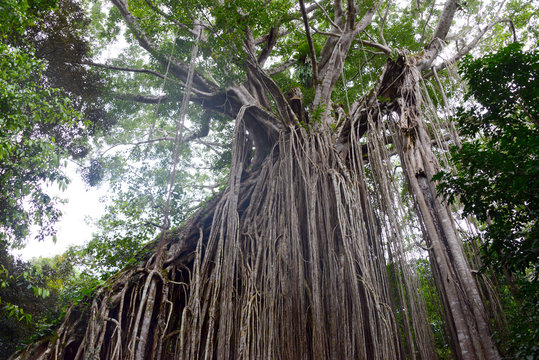The natural world is filled with awe-inspiring plants that captivate us with their unique adaptations and intriguing life cycles. One such plant is Ficus globrata, commonly known as the strangler fig. With its remarkable growth pattern and ecological significance, Ficus globrata is a fascinating species that deserves our attention. In this article, we will explore the captivating features of Ficus globrata and delve into its role in the ecosystem.
Origin and Distribution: Ficus globrata is a species of fig tree that belongs to the Moraceae family. It is native to the tropical regions of Southeast Asia, including countries such as India, Indonesia, Malaysia, and the Philippines. The tree thrives in warm and humid climates, typically found in rainforests and tropical lowland forests.

Ficus Globrata: Understanding the Unique Growth Pattern of a Tropical Epiphyte.
Growth Pattern and Unique Adaptations: What sets Ficus globrata apart from other trees is its growth pattern. It begins its life as an epiphyte, germinating on another tree, often high in the canopy. As it grows, Ficus globrata sends aerial roots downwards, eventually reaching the forest floor. These roots gradually fuse and form a lattice-like structure around the host tree. Over time, the fig’s roots envelop and constrict the host tree, eventually leading to its demise.
Ecological Importance: The strangler fig plays a crucial role in forest ecosystems. As an epiphyte, it starts life in the upper canopy, where sunlight is abundant. By growing down to the forest floor, Ficus globrata creates a bridge between the canopy and the understory, facilitating the exchange of nutrients, water, and even animal species. This vertical connectivity enhances biodiversity and promotes the survival of other organisms in the forest ecosystem.
Additionally, the fruits of Ficus globrata serve as a vital food source for many animals, including birds, bats, and primates. These animals help disperse the fig’s seeds over large distances, contributing to the tree’s reproductive success and expansion.
Cultural Significance and Human Uses: Throughout history, fig trees have held cultural and religious significance in many societies. Ficus globrata is no exception. In traditional medicine, various parts of the tree are used to treat ailments such as diabetes, skin diseases, and respiratory issues. The latex from its leaves and stem has also been utilized for its medicinal properties.
Beyond its medicinal uses, Ficus globrata has practical applications as well. The wood of the tree is durable and resistant to decay, making it suitable for crafting furniture, utensils, and other wooden implements. Additionally, the tree’s dense foliage provides shade, making it a popular choice for landscaping in tropical regions.

Preserving the Strangler Fig: The Importance of Ficus Globrata Conservation.
Conservation Status and Threats: As with many tropical tree species, Ficus globrata faces several threats to its survival. Habitat loss due to deforestation and land conversion poses a significant risk to the species. Additionally, overexploitation for timber and unsustainable harvesting for medicinal purposes can impact local populations. Conservation efforts, such as protected areas and sustainable management practices, are crucial for preserving the biodiversity and ecological balance of the forests where Ficus globrata thrives.

Traditional Medicine and Ficus Globrata: Unraveling its Healing Powers.
Beyond its captivating growth pattern and ecological importance, Ficus globrata, commonly known as the strangler fig, holds a treasure trove of health benefits. This remarkable plant has been revered in traditional medicine for centuries due to its various medicinal properties. In this article, we will delve into the health benefits associated with Ficus globrata and explore its potential in promoting well-being.
Rich in Antioxidants: Ficus globrata possesses a wealth of antioxidants, which are essential compounds that protect the body against oxidative stress. Oxidative stress occurs when there is an imbalance between free radicals and antioxidants in the body, leading to cellular damage and an increased risk of chronic diseases. The antioxidants found in Ficus globrata, including phenolic compounds and flavonoids, help neutralize free radicals and reduce oxidative damage, thus promoting overall health and longevity.
Anti-inflammatory Properties: Chronic inflammation is a common underlying factor in various diseases, including arthritis, cardiovascular conditions, and certain types of cancer. Ficus globrata has demonstrated potent anti-inflammatory properties, thanks to its bioactive compounds. These compounds help inhibit the production of inflammatory mediators, reducing inflammation and alleviating associated symptoms. Incorporating Ficus globrata into a balanced diet may contribute to the management and prevention of inflammatory conditions.
Digestive Health Support: In traditional medicine, Ficus globrata has long been used to promote digestive health. The latex obtained from the tree’s leaves and stem contains enzymes, such as ficin and bromelain, which aid in digestion by breaking down proteins. These enzymes facilitate the absorption of nutrients and promote proper digestion, relieving common digestive issues like indigestion, bloating, and constipation. Additionally, Ficus globrata possesses mild laxative properties, promoting regular bowel movements and maintaining gastrointestinal health.
Wound Healing and Skin Health: The latex of Ficus globrata has been traditionally used for its wound healing properties. When applied topically, the latex acts as a natural antiseptic, protecting wounds from infection and promoting faster healing. The tree’s latex also possesses astringent properties, which can help tighten and tone the skin, reducing the appearance of wrinkles and fine lines. Moreover, Ficus globrata is believed to have soothing effects on skin conditions such as eczema and psoriasis, providing relief from itchiness and inflammation.

Respiratory Support: Ficus globrata has been utilized in traditional medicine for its potential respiratory benefits. The plant’s leaves and latex are believed to possess expectorant properties, helping to alleviate coughs and congestion. Infusions or decoctions made from Ficus globrata leaves have been used to relieve symptoms of respiratory conditions such as asthma and bronchitis. However, it is important to consult with a healthcare professional before using any herbal remedies for respiratory ailments.
Caution and Considerations: While Ficus globrata offers potential health benefits, it is essential to exercise caution and seek expert advice. Some individuals may have allergies or sensitivities to the latex or other components of the plant. Furthermore, pregnant or breastfeeding women, as well as individuals with pre-existing medical conditions or taking medications, should consult their healthcare provider before incorporating Ficus globrata into their health regimen.

How useful was this post?
Click on a star to rate it!
Average rating / 5. Vote count:
No votes so far! Be the first to rate this post.
Author
-
Meet Dr. Kendall Gregory, a highly accomplished professional with a remarkable academic background and a deep passion for empowering individuals through knowledge. Dr. Gregory’s educational journey began with a Bachelor of Science degree, followed by a Doctor of Chiropractic Medicine, focusing on diagnosing and treating musculoskeletal conditions. He further expanded his expertise with a Master's degree in Oriental Medicine, specializing in acupuncture and Chinese herbology, and a Master's degree in Health Care Administration, emphasizing his dedication to improving healthcare systems. Dr. Gregory combines his extensive knowledge and practical experience to provide comprehensive and integrative healthcare solutions. Through his writings, he aims to inspire individuals to take charge of their health and make informed decisions.
View all posts








Visitor Rating: 5 Stars